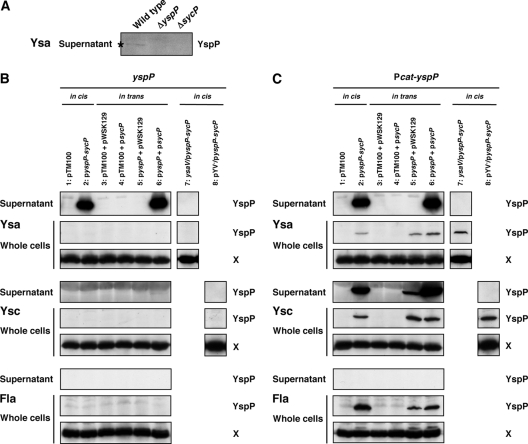FIG. 2.
YspP secretion in SycP-deficient mutant strains. (A) Western blot analysis of YspP in supernatants from wild-type (GY123), ΔyspP (GY5728), and ΔsycP (GY5729) strains. The strains were grown in Ysa-inducing medium, and the cells were then removed to collect the supernatants. The samples equivalent to a 20-OD600 cell culture were analyzed using a polyclonal anti-YspP antiserum. (B and C) Plasmid-based secretion analysis of YspP from different T3S systems in various genetic backgrounds. GY5774 (ΔyspP-sycP), GY5831 (ΔyspP-sycP ysaV), and GY5829 (ΔyspP-sycP pYV−) are shown carrying either one plasmid with the entire yspP-sycP locus (in cis) or two plasmids separating these genes (in trans). Strains were grown in Ysa-, Ysc-, or flagellum (Fla)-inducing medium. The samples from culture supernatant (OD600 of 1) and whole-cell (OD600 of 0.1) fractions were then analyzed by Western blotting using anti-YspP antiserum. A cross-reactive protein, labeled X, that was detected by anti-YspP antiserum served as a loading control. Abbreviations of the plasmids used are as follows: pyspP-sycP (pGY911 or pGY912), pyspP (pGY666 or pGY652), and psycP (pGY904). Transcription of yspP in pGY911 and pGY666 is directional to a chloramphenicol promoter (Pcat-yspP) in pTM100. Transcription of yspP in pGY912 and pGY652 is in the reverse orientation.

